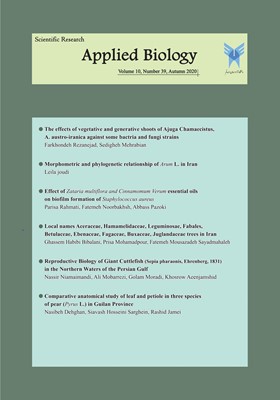Morphometric and phylogenetic relationship of Arum L. in Iran
Subject Areas :
botany
Leila Joudi
1
1 - Assistant Professor,Department of Agriculture, shabestar branch, Islamic Azad University, Shabestar, Iran.
Received: 2020-07-13
Accepted : 2020-10-07
Published : 2020-09-22
Keywords:
Cluster analysis,
Phylogenetic relationship,
bayesian,
Molecular marker,
maximum parsimony,
Abstract :
Objectives: In this research Arum species investigated based on molecular and morphological traits in order to new classification from Iran. Material and Methods: Plant materials were collected from nature or were prepared from herbarium. Statistical analysis was performed on morphological characters of Arum L. species. 29 qualitative and quantitative morphological characters were evaluated. trnL-F as plastid marker is widely used to infer phylogenetic relationships. Phylogenetic analyses were conducted by the Bayesian inference and maximum Parsimony methods. Results: Cluster analyses by ward method were classified the studied species based on morphological traits in three clusters. ClusterI included A. giganteum. ClusterII had A. conophaloides and A. viresence. ClusterIII divided in two groups: A. maculatum, A. kotschyi and A. korolkowii. Dendrogram of relationships was constructed by UPGMA, demonstrated four main clusters. A. maculatum and A. giganteum placed in separated clades. ClusterIII include two subclades: SubcladeI: A. conophaloides and subcladeII: A. virescence, A. korolkowii and A. kotschyi. Cladistics analysis of phylogenetic relationships indicated that all species constituted monophyletic group within Arae clade. A. maculatum was separated in different place. A. kotschyi and A. korolkowii with A. rupicola from gene bank were introduced as sister groups. Arum virescens, A. conophaloides and A. giganteum were separated from A. ruoicola. In general, the morphological and molecular results are consistent.
References:
Ghahreman A. Plant systematics, Coromophytes of Iran.Vol.3. Iran university press. 1994. [In Persian]
Boyce PC & Croat TB. The Uberlist of Araceae, Totals for Published and Estimated Number of Species in Aroid Genera. 2011. Available at: http://www.aroid.org/genera uberlist.
Espindola A, Buerki S, Bedalov M, Kupfer P & Alvarez N. New insights into the phylogenetic and biogeography of arum (araceae): unravelling its evolutionary history. Bot. J. Linn. Soc. 2010; 163:14–32.
Chouteau M, Gibernau M & Barabe D. Relationships between floral characters, pollination mechanisms, life forms, and habitats in Araceae. Bot. J. Linn. Soc. 2008; 156: 29–42.
Gholipour A, Sonboli A. Rediscovery of Acorus calamus (Acoraceae) in Iran. Taxonomy and Biosystematics Journal (TBJ). 2014; 15: 113-116. [In Persian].
Boyce PC. Arum - a decade of change. Aroideana. 2006; 29: 132–9.
Assadi M. Flora of Iran. Research Institute of Forest and Rangelands, National Botanical Garden of Iran; 1988, N: 2.20 pages.[In Persian]
Riedl H. Flora Iranica. 1963; N:2.
Cusimano N & et al. Relationships within the araceae: comparison of morphological patterns with molecular phylogenies. Amer. J. Bot. 2011; 98: 654-668.
Cusimano N, Barrett MD, Hetterscheid WLA & Renner SA. Phylogeny of the Areae (Araceae) implies that Typhonium, Sauromatum, and the Australian species of Typhonium are distinct clades. Taxon. 2010; 59: 439-447.
Cabrera LI & et al. Phylogenetic relationships of aroids and duckweeds (Araceae) inferred from coding and noncoding plastid DNA. Amer. J. Bot. 2008; 95: 1153–1165.
Keating RC. Collenchyma in Araceae: Trends and relation to classification. Bot. J. Linn. Soc. 2000; 134: 203-214.
Bogner J, Johnson KR, Kvacek Z & Upchurch GR. New fossil leaves of Araceae from the Late Cretaceous and Paleogene of western North America. Zitteliana. 2007; 47: 133-147.
Boyce PC. The genus Arum (A Kew magazine monograph). London: Royal Botanic Gardens; 1993: 235.
Keshavarzi M, Babaei Kh, Seifali M & Jaleh Safaeipour J. Evaluation of Morphological Diversity and Determination of Eremopyrum Genetic Identification Key in Iran. Quarterly Journal of Research and Manufacturing. 2006; 1(1).
Hennig, W.1966. Phylogenetic Systematics. (University of IIIinois Press: rbana,IIIinois).
Maddison WP & Maddison DR. Mesquite (version 2.74): A modular system for evolutionary analysis. 2010. Available at: http://mesquiteproject.org
Swofford DL. Phylogenetic analysis using parsimony (PAUP). Ver.4. Sinauer Associated Sunderlandm Massachusetts; 2002. DOI: 10.1111/j.0014-3820.2002.tb00191.x.
Ronquist F & Huelsenbeck JP. Bioinformatics. 2003;19:1572-1574.
Gibernau M, Favre Ch, Talou T & Raynaud Ch. Floral odor of Arum italicum. Aroideana. 2004; 27:142-147.
Mansion G, Rosenbaum G, Schoenenberger N, Bacchetta G, Rosselló JA & Conti E. Phylogenetic analysis informed by geological history supports multiple, sequential invasions of the Mediterranean Basin by the angiosperm family Araceae. Syst. Biol. 2008; 57: 269-285.
Linz J, Stökl J, Urru I, Krügel T, Stensmyr M. Molecular phylogeny of the genus Arum (Araceae) inferred from multi-locus sequence data and AFLPs. Taxon. 2010; 59: 405-415.
Joudi L, Mehregan I, Assadi M & Farajzadeh D. Molecular phylogeny of the family Araceae as inferred from the nuclear ribosomal ITS data. IJGP. 2017; 5: 32-39.
Boyce PC. Plant portrait. Arum pictum. Bot. Mag. (Kew Mag.). 1988; 5: 72–76.
Akaike H. A new look at the statistical model identification. IEEE Transactions on Automatic Control. 1974; 19: 718-723.
Mayo SJ, Bogner J & Boyce PC. The genera of Araceae. U.K: The Trustees, Royal Botanic Gardens57; 1997.
_||_


